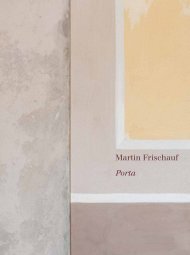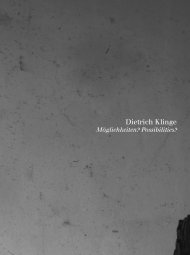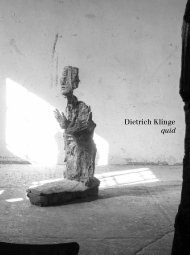Katalog_Portus_für_Jumpu
You also want an ePaper? Increase the reach of your titles
YUMPU automatically turns print PDFs into web optimized ePapers that Google loves.
The Portus was conceived in part as a display space for the sculptor
– a place to physically consider his work alone or with colleagues
and friends.
Although decidedly a Contemporary artist, Klinge has been engaged
with breadth of the history of art since his childhood. Recollections
of Durer populate his early memories. Later, Rembrandt. But the
affinities are largely intellectual and psychological. In more recent
times, historical manuscripts and book paintings have captured his
attention and, with characteristic intensity, has led to a level of connoisseurship
that rivals trained academics and curators. Yet, it is
a communion with historical sculptures, frequently fragmentary,
from across time and place that is most meaningful and insightful.
He has closely studied and occasionally acquired sculptures, most
frequently heads, from across the Ancient world to Africa to Cambodia
and beyond. Rodin even appears in his collection. In addition
to the opportunity to display his own work, the Portus offered the
potential to show works from his own collection. The inaugural display
is the first of many in a series he plans over time.
94 95
As an exhibition space rather than a studio space, it is important to
note that the Portus was conceived and realized by a mature artist
with an extraordinary and diverse exhibition history. As anticipated,
Klinge himself has been intensely involved in the plan and installation
of every venue that has hosted his work. There have been a
multitude of traditional gallery and museum spaces as venues. The
“white cubes” as it were. Certainly, the sculptures have been successful
within the minimalist rigors of such environments. However,
Klinge has been exceedingly successful in a wide variety of historical
venues from chapels and churches, active and deconsecrated,
to castles and historic homes, to rehabilitated mills and industrial
sites. Often both interior rooms and exteriors spaces, like gardens
and cloisters, have been employed. Although he is not unique among
Contemporary artists exhibiting in such venues, he is in the decided
minority that does not want to conquer historical spaces but live
within and expand their sense of time and place; past informs the
present, the present expands the past. Such sympathies are harmonious
with his admiration and collection of historical works.
Unlike the studio described by Courbet in his painting, Klinge’s Portus
is not a space for creating works of art as his studio spaces in Weidelbach
suffice. However, in sympathy with Courbet’s illusionistic
space as a work of art, the collective experience of entering Klinge’s
new building is like entering a work of art. At multiple levels, there
is both insightful revelation and opportunities for contemplation. It
is perhaps one of his most personal and insightful accomplishments
shared to date. Moreover, it is sympathetic with the allegorical nature
of Courbet’s painting as an environment, albeit physically experiential,
that is replete with symbolic and physical connections to
Klinge’s art. In broadest terms, one might consider the whole experience
to be something of an installation as work of art more than
installation as a venue for the display of art. This seems an honest
undertaking for an artist wherein installation work was a part of
his early career.
Surveying the airy and light-filled interior of the Portus, the individuality
and variety of the three-dimensional objects falls calm to
a sense of community. The human form governs. There are those
sculptures which are full figure and there are those which are fragmentary;
the head, in particular, reigns. A few sculptures are slightly
over life-size, but most are measurably human scale and smaller.
Regardless of scale, the careful arrangement and display of works
within the space encourages an air of equality. There seems as
much visual power in a towering seated figure as there is in a head
that could easily fit in the palm of one’s hand. Nearly every sculptural
medium is on view: bronze, iron, wood, stone, and marble. So
too, carving and casting are represented in nearly equal measure;
save for the fabrication or constructivist impulses of more recent art
















